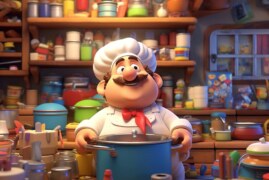Brown is an essential color in the kitchen, not just for foods but also for presenting them. However, getting the perfect shade of brown can be a bit tricky with just the ingredients you have on hand. That’s where food coloring comes in handy! With a few tips and tricks, you can easily make brown with food coloring, whether you’re looking to dye frosting or give a dish a more appetizing appearance. In this article, we’ll guide you through the process of creating rich, warm hues of brown with food coloring and provide you with some inspiration for using this color in your cooking. So, let’s dive in!
1. Understanding the Basics of Food Coloring: A Brief Introduction
Before diving into the process of making brown food coloring at home, it’s helpful to have a basic understanding of what food coloring is and how it works. Food coloring is a common kitchen ingredient that is used to add vibrant colors to baked goods, candies, and other foods. It’s a convenient way to enhance the visual appeal of food and make it more exciting to eat.
Food coloring comes in different forms, including liquid, gel, and powder. Liquid food coloring is the most common and is available in most grocery stores. Gel food coloring is more concentrated and offers a more intense color, but it can be harder to find in stores. Powder food coloring is the least common and mainly used by professional bakers and pastry chefs.
Food coloring is made up of synthetic or natural ingredients that are safe to consume. Some food colors are made from plant extracts, while others are created through chemical reactions. Regardless of the type, food coloring is carefully regulated by food safety agencies to ensure that it’s safe for consumption.
In the next section, we will discuss the different types of food coloring and which ones are best for making brown food coloring.
2. The Different Types of Food Coloring and Which Ones Are Best for Making Brown
Understanding the different types of food coloring available in the market is crucial to achieving the perfect shade of brown. There are three types of food coloring: liquid, gel, and powder. All three work well for making brown, but each has its unique features.
Liquid Food Coloring
Liquid food coloring is the most commonly used type of food coloring. It’s available in a wide range of shades and is easy to use. However, when it comes to making brown food coloring with liquid food coloring, it can be a bit tricky. You need to mix several drops of red, green, and yellow food coloring to achieve the desired shade of brown. Be careful not to overdo it with any one of these colors, as it can ruin the shade.
Gel Food Coloring
Gel food coloring is more concentrated than liquid food coloring and has a thicker consistency, which means you need to use less of it. It’s available in a wide range of shades, and you can mix different shades to create a custom shade of brown. To make brown food coloring with gel food coloring, mix red, yellow, and green in equal parts. The result is a beautiful shade of brown.
Powder Food Coloring
Powder food coloring is a bit tricky to work with, but it’s the most concentrated of all the food colorings. It’s also the easiest to store, as it doesn’t dry out like liquid or gel food coloring. To create brown food coloring with powder food coloring, mix red and green powder food coloring in equal parts until you achieve the desired brown shade.
In conclusion, all three types of food coloring work well for making brown, but it’s important to consider the needs of your recipe and the desired shade of brown when choosing the right type of food coloring. Experiment with different combinations of colors until you achieve the perfect shade of brown to enhance the visual appeal of your dishes.
3. Step-by-Step Guide to Making Brown Food Coloring at Home
Now that we have discussed the basics of food coloring and the different types best suited for making brown, it’s time to learn how to make brown food coloring at home. Here’s a step-by-step guide to make brown food coloring with ease:
Step 1: Start with the Primary Colors
To make brown food coloring, you’ll need to start with the primary colors – red, blue, and yellow. The exact amounts you’ll need depend on the shade of brown you’re trying to achieve. Make sure you have these colors on hand before starting.
Step 2: Mix Yellow and Blue to Make Green
In a small mixing bowl, mix equal parts of yellow and blue food coloring to create green. Use a toothpick or small spoon to mix these two colors until they’ve blended properly. Remember, the more yellow you add, the lighter the green will be, and vice versa.
Step 3: Add Red Food Coloring
Add red food coloring to the green mixture. Gradually add drops until you have achieved a brownish hue. Use a toothpick to blend the color properly. Red adds warmth to the green mixture and helps to create a well-balanced brown color.
Step 4: Adjust the Shade
If the color is too light or too dark, adjust the shade by adding more of the primary colors. For a darker shade, add more red food coloring. For a lighter shade, add more yellow and blue.
Making brown food coloring at home is an easy and cost-effective way to add a touch of warmth and depth to your baked goodies or cooking. With these simple steps, you can now create various shades of brown that’s perfect for any culinary creation.
4. Tips and Tricks for Achieving the Perfect Shade of Brown with Food Coloring
Once you have made your homemade brown food coloring, the next step is to achieve the perfect shade of brown for your dish. Use these tips and tricks to get the exact color you desire:
Use small amounts for a subtle effect
Keep in mind that a little bit of food coloring goes a long way, especially when it comes to darker colors like brown. Start with a small amount of coloring and increase gradually until you get the desired shade. Remember that you can always add more, but you can’t take away, so use caution and go slow.
Mix colors for a custom shade
If you want to create a unique shade of brown, consider mixing two or more colors together. For example, combine red and green food coloring to make a reddish-brown hue or mix blue and yellow coloring to make a cooler-toned brown. Experiment with different color combinations until you find one that works for your recipe.
Use natural food dye alternatives
If you prefer to use natural ingredients to color your food, there are several options for achieving a brown hue. Try using cocoa powder, coffee or tea as a natural coloring agent. These ingredients not only add color but also enhance the flavor profile of your dish. Overall, there are plenty of ways to achieve the perfect shade of brown with food coloring. By following these tips, you’ll be able to create a beautiful and tasty dish that everyone will love.
5. Using Brown Food Coloring in Your Baking and Cooking: Creative Ideas and Recipes
Using brown food coloring in your baking and cooking can add a new dimension of flavor and visual appeal to your dishes. From sweet to savory, there are many creative ideas and recipes that you can explore that make the most of this versatile ingredient.
Sweet Dishes:
1. Chocolate chip cookies: Bring a rich color to your chocolate chip cookies by adding a few drops of brown food coloring to your batter. It will help to create a deeper color and a more intense flavor.
2. Brownies: If you love rich, fudgy brownies, add a teaspoon of brown food coloring to your mix to make the color more intense and to give it a more chocolatey flavor.
3. Cake: Create a beautiful, rich brown color by adding a few drops of brown food coloring to your cake batter. The color will be more intense and beautiful with the right use of brown food coloring.
Savory Dishes:
1. Gravy: A brown color in gravy is a sign that it has been well-made. Add a few drops of brown food coloring to your gravy to get the right color and flavor that your family and friends will love.
2. Meat: Adding brown food coloring to meat dishes such as beef, pork, or chicken not only helps to create a beautiful, rich color but also adds an element of flavor to the dish.
3. Soups: Brown food coloring is a great addition to soups such as French onion soup, which requires a deep, rich color to look and taste authentic.
In conclusion, adding brown food coloring to your dishes is a simple way to take them to the next level. These creative ideas and recipes can help you explore all the possibilities that brown food coloring can offer. Make sure to use it in moderation and mix it well with other ingredients to create the perfect shade for your dishes.
People Also Ask
How do you make brown with primary colors?
To make brown with primary colors, you need to mix equal parts of red, blue, and yellow. This will create a muddy, brown color. Adjust the ratio of each color to make the brown lighter or darker.
What colors do you mix to make dark brown?
To make dark brown, mix red, blue, and yellow in a 3:1:1 ratio. This creates a rich, chocolate brown color. Add more or less of each color to adjust the darkness of the brown.
Can you make brown out of food coloring?
Yes, you can make brown out of food coloring. Mix red, blue, and yellow food coloring in equal parts. You may need to adjust the ratio to make the brown lighter or darker.
How much food coloring do you need to make brown?
To make brown with food coloring, mix equal parts of red, blue, and yellow food coloring. You only need a few drops of each color to create a rich, brown color. Adjust the amount of each color to make the brown lighter or darker.
What is the best food coloring for making brown?
Gel food coloring is the best option for making brown. It is more concentrated than liquid food coloring, so you need less of it to achieve the desired color. Use a small amount of gel food coloring and mix it with other colors to create brown.
Conclusion
In conclusion, to make brown with food coloring, mix equal parts of red, blue, and yellow food coloring. You can adjust the ratio of each color to create lighter or darker shades of brown. Gel food coloring is the best option, as it is more concentrated and requires less to achieve your desired color. Happy coloring!



